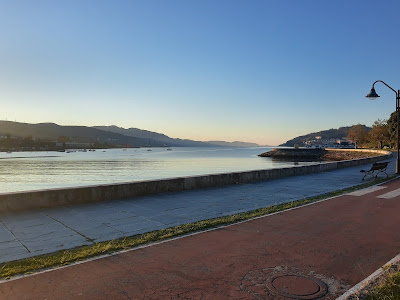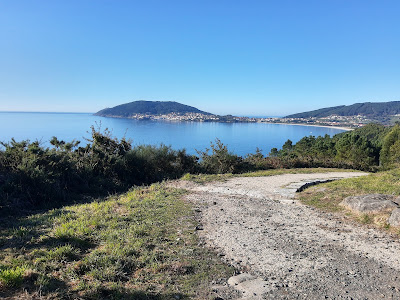Diana had to return to Canada on Sunday, but I had enjoyed the Camino Portugues so much that I decided to add on four more days of walking and continue on to Fisterra (or Finisterra), "the end of the world."
I picked up my credentials at the Santiago pilgrim's office on Saturday night.
The camino pre-dates Christianity and before Santiago was the destination it was apparently Fisterra, which was thought to literally be the end of land and where one could watch the sun die each night. While most pilgrims nowadays finish in Santiago, the extension to Fisterra (or Muxia) is still popular.
In the afternoon and evening this street outside of the hotel I stayed at Saturday night is packed, but on Sunday morning as I prepared to leave, it was deserted.
So was the first kilometre or so of my route as I headed away from the cathedral.
This was my first marker of the Camino Fisterra.
Somehow you leave Santiago in no time, and soon I could look back across fields and forest and see the cathedral spires above the city.
I had twenty kilometres to walk today, and it was a lovely route.
I passed through Ponte Maceira, which is supposed to be one of Spain's most beautiful spots.
I reached Negreira around 14:00. I pushed hard the last hour or so because it was getting quite hot and I was hungry!
Monday was my longest day of walking, thirty-two kilometres in all, so I got an early start. I was rewarded with a gorgeous sunrise as I climbed out of Negreira.
Certainly thirty-two kilometres was a lot of walking, and I certainly felt it, but I think Monday was my favourite stretch out of the ten days of walking I did in total from Valenca to Fisterra. The scenery was mostly rural, but varied nonetheless, and the terrain undulating without being especially challenging.
On Tuesday morning there was some fog as I left Olveira, and it was cold! I stopped after only two kilometres for coffee and a croissant, but mostly to warm up!
Luckily it warmed up quickly. Soon after Olveira there was climb up to a ridge, with a beautiful view.
This lovely facility is at a place called Hospital, but unfortunately it was closed.
After Hospital the way splits, with northwest heading towards Muxia and southwest to Fisterra. The fifteen kilometres from the divide to Cee (where I was spending the night) is the remotest stretch I walked out of all ten days. This meant I was very hungry by the time I reached out Cee, but it was a lovely stretch.
At Cee I was now at the ocean, and walked down to the beach to watch the sunset.
Given my proximity to the sea, I made sure to enjoy some seafood (arròs negre) for dinner.
Yesterday was my tenth and final and shortest (16 kilometres) day of walking, and it was bittersweet, in a way. It was another lovely walk, but sad that it was the final day.
From Cee as I walked around the bay I was in Corcubion
From Corcubion the route moves upwards over a peninsula.
On the other side of the peninsula is a place called Sardineiro de Abaixo, with a nice beach, and where I stopped for coffee.
The coffee was lovely as usual, but the generous piece of cake served on the side was to die for!
Soon I passed this sign . . .
I walked along the beach for awhile.
And then up into the town.
I stopped for lunch here and rested for awhile, but my hotel was not open yet, so I could not check in. I left some of my stuff outside anyway, and then carried on the last few kilometres.
At the cape there is a lighthouse, . . .
. . . a cross, of course, . . .
. . . a zero kilometre marker . . .
. . . and a boot!
And besides all of that, an expansive view of the ocean stretching as far as you can see: the end of the world.
The town of Fisterra is on the inland (eastern) side of the peninsula, so at sunset I walked west to the other side where there is a beach and where I could watch the sun "die" as apparently people have for millennia. It was a nice way to end a wonderful pilgrimage.





























































No comments:
Post a Comment